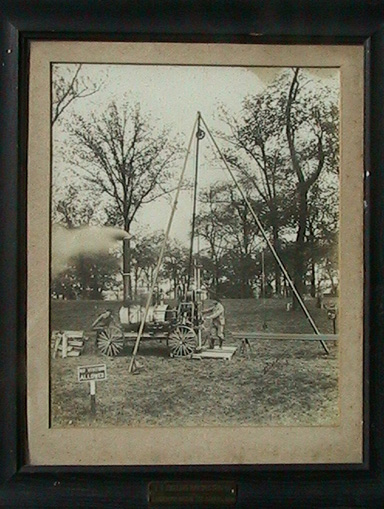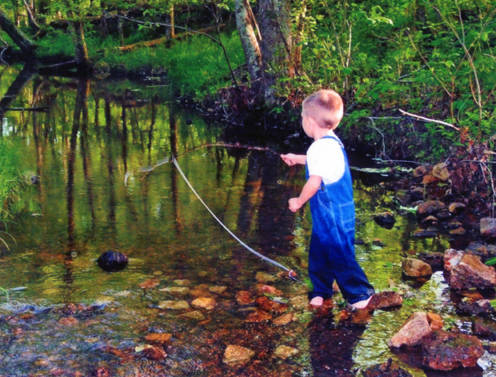Deep Drill No.1..."Then Came That Sound...the sound of water!"
The Artesian Well

Deep Drill No.1
The year is 1914. The Valle Mining Company decides to prospect for lead ore but much deeper down than its usual 100 ft.
surface mines, this time HUNDREDS of feet down, down into the Bonne Terre Formation, perhaps to find
the Viburnum Trend lead and its unlimited wealth. But The One Question: "Does the Trend reach this far
north into our Southeast Missouri Lead Belt?" At the time, a steam-powered diamond core drill (see picture, left) was
the only technology that could find out.
At first, the day's drilling proved nothing. Over and over, the decision came down. "We'll go deeper!"
100, 200, 400, 800 feet deep they drilled, still nothing. Then came that sound...the sound of water!
At 840 feet they struck an underground river. What was once a dry drill hole transformed in seconds
into a river. Water gushed out at 75 gallons per minute, enough to fill a modern day drywall bucket
in 4 seconds.
It took 50 years for the Missouri Dept. of Natural Resources to trace the source
of the water 200 miles south, back to an underground river in Arkansas. That river feeds this well
from deep within the aquafer to this day. People drive hundreds of miles to fill their water jugs, regularly from Illinois with our
farthest visitors coming from... New Zealand! recently. The oldest man in town credits his old age to the water, drinking it
every day. To see how pure it really is and what's in it, Click Here
The Well continues to flow 111+ years later. Even during the worst droughts, the well
continues to produce.
 It drains nearby into the creek
which has the perfect pool (3 feet deep) to the left for training new anglers or just
getting kids wet on a hot day (watch the rocks, they can be slippery).
It drains nearby into the creek
which has the perfect pool (3 feet deep) to the left for training new anglers or just
getting kids wet on a hot day (watch the rocks, they can be slippery).
105+ years later, even during the worst drought, the well continues to produce. Nearby
wells recently have diminished its volume but the purity and rare flavor endures to this day. A great place for a
microbrewery if you know someone who wants to start one.
The Two Mysteries of Drill Hole No.2
Mystery #1: Drill Hole No.2 According to logs, not only did the driller strike an underground river
in Drill Hole No.1 but next, and only a mile away by the Big Lode Mine, he struck a huge deposit of lead
in Drill Hole No.2.
When he brought up that drill core they had drilled through 6 feet of lead. Although the largest hand-mined
lead nugget at Valles Mines proved to be about the size of a Volkswagen Beetle, this discovery rated as even bigger.
Mystery #2 For reasons unknown, The Valle Mining Company never pursued this gigantic prospecting revelation. Instead, they tried to
follow up on the zinc discoveries around the Garotte
in hopes of extending the Garotte
Mine which had no particular end in sight at that time.
But unexpectedly instead, all operations ended totally within months when the Edgar Zinc Smelter on the river in Carondolet
had to close. Months later World War I started
and 4 million able-bodied men (read: most of the miners in the lead belt) started their new lives as soldiers
and in 1918-1920, brought back the Spanish Flu Pandemic, as well as
204,000 wounded, and 116,708 dead. Few came home afterwards to mine. You had to be a "bull of a man" to break through solid rock and carry ore every day.
The automobile had arrived, the 1904 World's Fair promised electric lights. A pickaxe had been the main mining tool. The world was changing.
With this setback to the Company, operations essentially ceased and the Mining Company shut down.
Drill Hole No.2 based on old survey maps is located about 100
feet south of the Frazier Quarry downhill from the "Big Bill" Mine's twin shafts and faces towards the Big Lode Mine.
The precise depth of the strike has been lost to history. Deep Drill No.2 relocation remains a project
for a metal detector because the 10 foot tall iron casing pounded in to guide the drill remains in place to this day a foot or two under the surface waiting for
its rediscovery.
Aside from the lead, the Board of the Company perhaps they should have taken up
Perhaps the Board should have taken Mr. Finney up on his offer to pump the flooded Garotte Mine at Drill Hole No.6 but Welton
Rozier, VMC president, died in 1928 after trying unsuccessfully for years to build his own zinc smelter on the property. Having sold
all the mature timber to the Egyptian Tie & Timber Company the year before, there was not enough fuelwood left to power a smelter of sufficient size.
While that flooded zinc mine was "proven", its deposits were never mined. Its location is well known today as recently a spelunking team
followed the underground surveys of the era to verify its location and that its hypogene cave passages are still flooded.